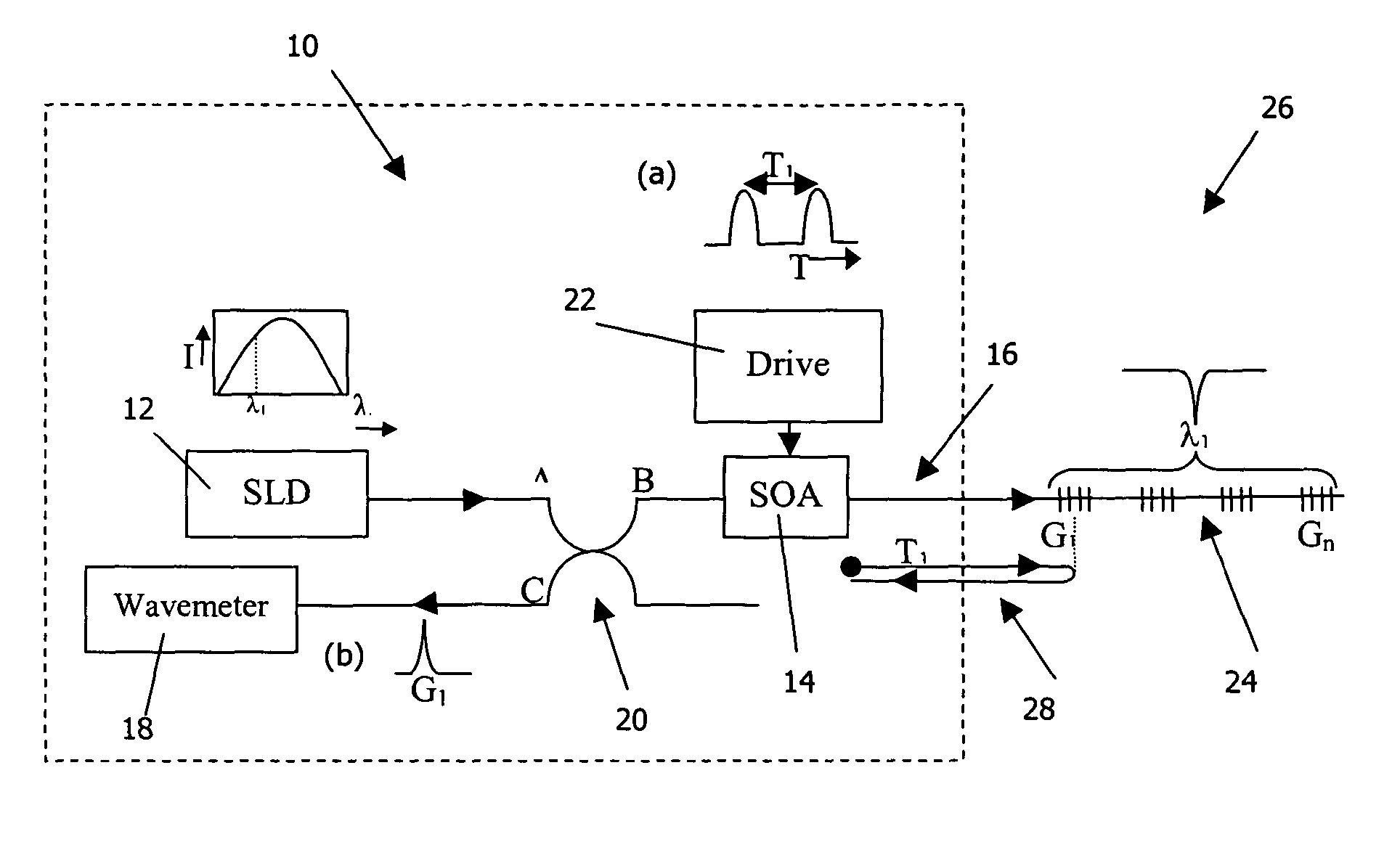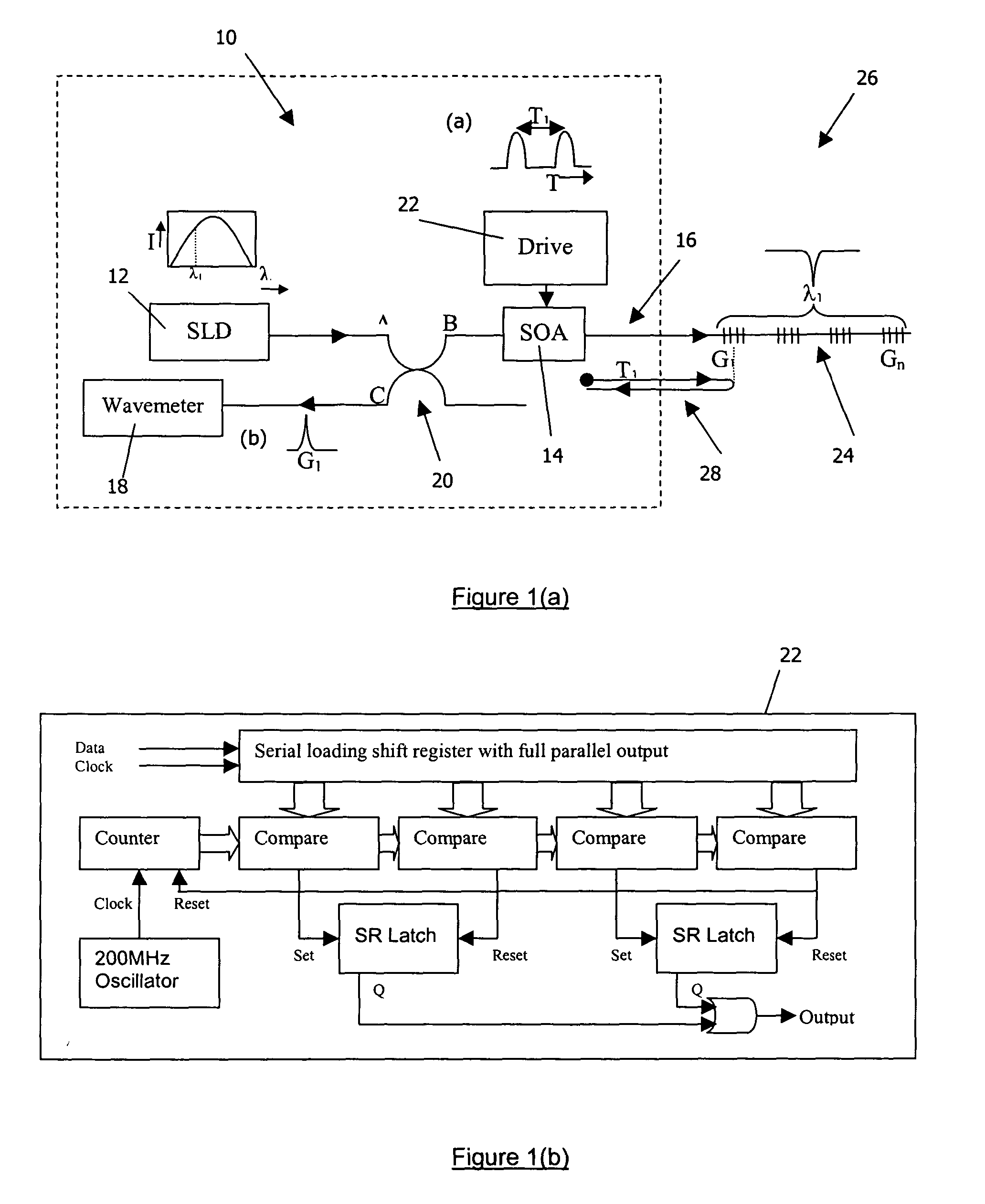Optical interrogation system and sensor system
an interrogation system and optical technology, applied in the direction of converting sensor output, electromagnetic transmission, transmission, etc., can solve the problems of wavelength measurement system, wavelength measurement system, and the operating bandwidth of optical source and wavelength measurement system
- Summary
- Abstract
- Description
- Claims
- Application Information
AI Technical Summary
Benefits of technology
Problems solved by technology
Method used
Image
Examples
first embodiment
[0073] the invention provides an optical interrogation system 10, as shown in FIG. 1(a). The interrogation system 10 comprises an optical source 12, 14 operable to generate optical pulses, to be coupled into an optical waveguide 16 containing reflective optical elements, in this example gratings G, to be interrogated. The interrogation system 10 further comprises optical amplifying and gating means, which in this example takes the form of a bi-directionally operable semiconductor optical amplifier (SOA) 14. The SOA 14 is optically coupled to the waveguide 16 containing the gratings G to be interrogated. The interrogation system 10 also comprises optical detection means, which in this example takes the form of a wavemeter 18 optically coupled to the SOA 14. The wavemeter 18 is operable to evaluate the wavelength of a returned optical pulse transmitted by the SOA 14.
[0074] In this example, the optical source comprises a continuous wave (CW) optical source, in the form of a super-lumin...
second embodiment
[0081] To interrogate one or more reflective optical elements the interrogation system 10 is coupled to an optical waveguide containing one or more reflective optical elements to be interrogated. In this example, the interrogation system 10 is shown coupled to an optical fibre 16 including a sensing section 24 in which an array of fibre Bragg gratings (G.sub.1 to G.sub.n) are provided. The interrogation system 10 and the array of gratings together form an optical sensor system 26 according to the invention, each of the gratings G within the array forming a sensing element. The resonant wavelengths of each of the gratings G are substantially the same in this example, each grating G therefore operating within the same optical channel. In this example the gratings G are 2.5 mm in length and have a resonant wavelength of 1550 nm, a spectral bandwidth of 0.2 nm and a transmission loss of 4%. The four gratings shown in FIG. 1(a) are intended to illustrate an array of up to n gratings, whe...
fourth embodiment
[0101] When the interrogation system 30 is coupled to the optical fibre 16 containing an array of gratings G to be interrogated, as described above, they together form an optical fibre grating sensor system 34 according to the invention.
[0102] FIG. 4 shows an optical interrogation system 40 according to a fifth embodiment of the invention. The interrogation system 40 of this embodiment is substantially the same as the interrogation system 30 according to the third embodiment, with the following modification. The same reference numerals are retained for corresponding features.
PUM
| Property | Measurement | Unit |
|---|---|---|
| velocity | aaaaa | aaaaa |
| reflectivity | aaaaa | aaaaa |
| reflectivity | aaaaa | aaaaa |
Abstract
Description
Claims
Application Information
 Login to View More
Login to View More - R&D
- Intellectual Property
- Life Sciences
- Materials
- Tech Scout
- Unparalleled Data Quality
- Higher Quality Content
- 60% Fewer Hallucinations
Browse by: Latest US Patents, China's latest patents, Technical Efficacy Thesaurus, Application Domain, Technology Topic, Popular Technical Reports.
© 2025 PatSnap. All rights reserved.Legal|Privacy policy|Modern Slavery Act Transparency Statement|Sitemap|About US| Contact US: help@patsnap.com



